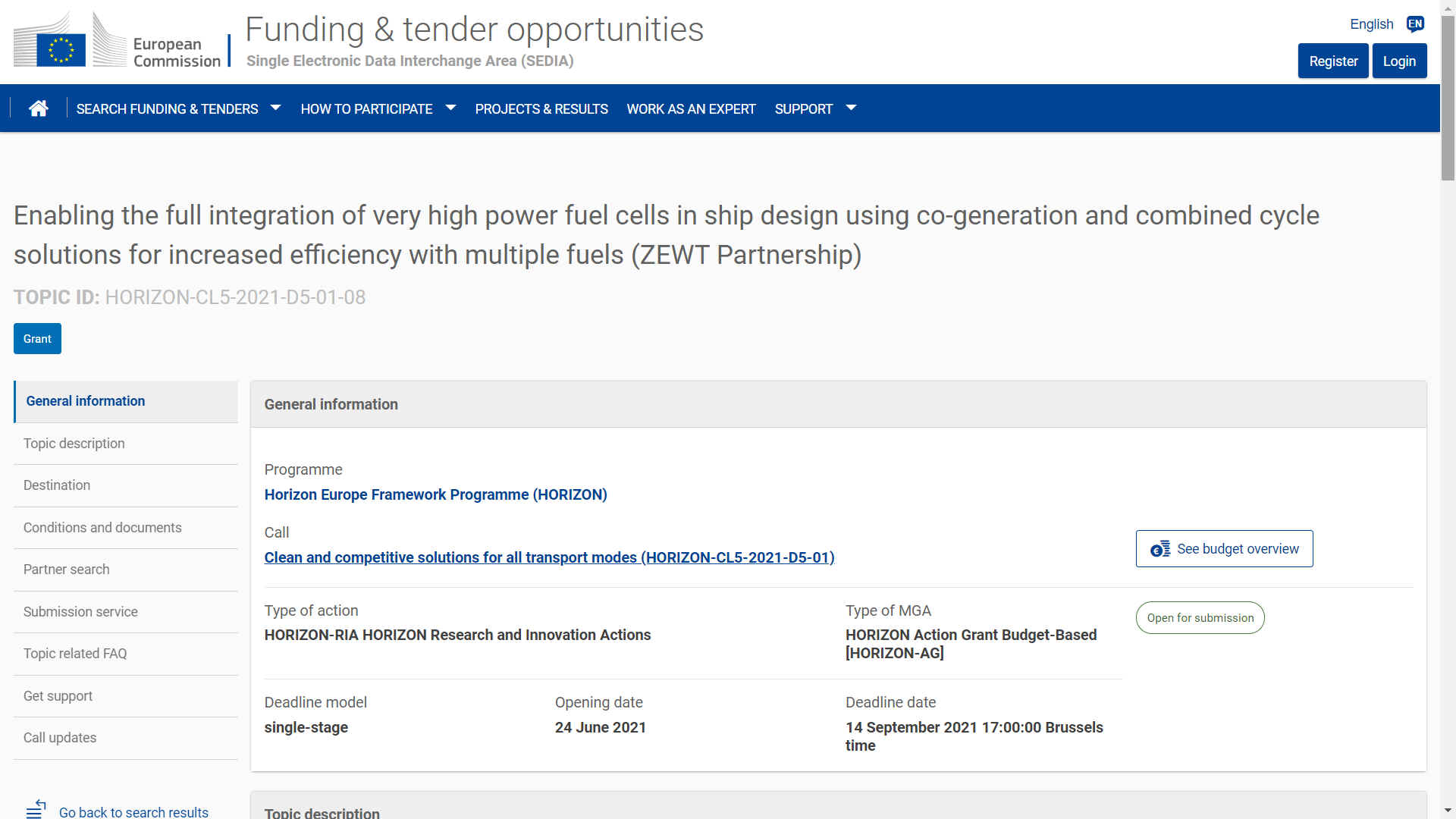|
2021-2022
MARITIME – ZEWT TOPICS - DEADLINE 7th SEPTEMBER 2021
Type of Action: Innovation Action (RIA)
TRL:
5
Expected EU contribution per project (M€) = €15m
Number of projects to be funded = 1 @ €15 million
ZEWT Partnership – Zero Emission Waterborne Transport
EXPECTED OUTCOME:
Project outputs and results are expected to contribute concretely to the following expected outcomes as marked (“*”) whilst supporting the overall medium and longer term objectives:
Establishing the basis for achieving TRL 8 in on-board use of high power fuel cells by 2030.
* Feasibility and technical demonstration of the use of high-power fuel cells in co-generation and/or combined cycle mode in waterborne transport.
* Proof of scaling up, to a target of significantly above 3 MW power output, of fuel cell installations for all shipping applications, including main propulsion of a short sea shipping or inland navigation vessel.
* In case of a fuel cell using fossil fuel as input proof of significant efficiency gains (at least 20%) in a realistic environment compared to the conventional use of the fuels (e.g. within an ICE) with consequent reduction in GHG emissions.
* Demonstration of the exploitation on-board of waste thermal energy produced by high temperature fuel cells in ship-specific applications (e.g. hot water, steam production, HVAC, etc.) for potential mass-market application.
* Showing a realistic pathway to the wider use of fuel cell technology in waterborne transport including the assessment of the maturity and resulting mid-term potential of various fuel cell systems. This may include an initial focus on lower power propulsion applications in inland navigation where power reserves for adverse sailing conditions are less relevant.
SCOPE:
The use of fuel cells (FC) for waterborne applications is becoming increasingly relevant as stack power increases and the problem of the storage of un-regulated alternative fuels is solved. Demonstrating and upscaling this technology will lead to initial and earlier applications in IWT and short sea shipping vessels, as well as to complementary power generation on-board ships with high power demand, whilst also setting foundations towards deployment within even larger scale long distance applications.
Whilst previous projects have addressed applicability of mainly smaller fuel cell systems on-board, the full integration of very high power fuel cells on-board large ships represents a major challenge.
The total efficiency of high temperature FCs, using a variety of fuels, can be substantially increased through their use within a combined cycle, recovering secondary heat or using them in combination with secondary combustion systems. Whilst such installations are operating on land with substantial improvements in energy efficiency compared to an internal combustion engine, a fully integrated dual cycle multi-MW FC system has yet to be achieved on-board a ship. Regardless of the fuel used efficiency improvements would be expected to substantially contribute to climate neutrality as well as moving towards high power 100% hydrogen operations.
The aim is to prove the use of high-temperature FCs in a co-generation and combined cycle mode, either on a ship powered uniquely by FCs, or on-board a large ship with high power demand together with other power and thermal energy generation and management systems. Solutions need to address comprehensively the complexity of ship integration, e.g. the balance of plant components, batteries for dynamic loads and waste heat recovery systems.
A demonstrator of a high-temperature system as a large efficient unit will be developed and installed on-board a suitable vessel, and the budget foreseen reflects this ambition. The power of the FC will aim to exceed significantly 3 MW. The system may be run with conventional fossil fuels, with the use of an internal reformer. In this case the system needs to show a significant efficiency gain in terms of reduced GHG emissions compared to the conventional use of the fuel. Overall, the superiority of a FC solution over conventional ICEs should be demonstrated in a comparable arrangement. This may include an IWT application with less power to show the early marketability of the concept and its applicability on a large scale.
Initial target applications are those where the existing regulatory framework facilitates the introduction of a prototype which may depend on the sector of application, the ship type or the fuel used. The project should address the propulsion architecture and/or the electric system, but it shall not address the development of new FCs per se.
This topic implements the co-programmed European Partnership on ‘Zero Emission Waterborne
Transport’ (ZEWT).
Specific Topic Conditions:
Activities are expected to achieve TRL 5 by the end of the project – see General Annex B.
Cross-cutting Priorities:
Co-programmed European Partnerships
Ocean sustainability and blue economy
CLEAN AND COMPETITIVE COLUTIONS FOR ALL TRANSPORT MODES
This Destination addresses activities that improve the climate and environmental footprint, as well as competitiveness, of different transport modes.
The transport sector is responsible for 23% of CO2 emissions and remains dependent on oil for 92% of its energy demand. While there has been significant technological progress over past decades, projected
GHG emissions are not in line with the objectives of the Paris Agreement due to the expected increase in transport demand. Intensified research and innovation activities are therefore needed, across all transport modes and in line with societal needs and preferences, in order for the EU to reach its policy goals towards a net-zero greenhouse gas emissions by 2050 and to reduce significantly air pollutants.
The areas of rail and air traffic management will be addressed through dedicated Institutional European Partnerships and are therefore not included in this document.
This Destination contributes to the following Strategic Plan’s Key Strategic Orientations (KSO):
C: Making Europe the first digitally enabled circular, climate-neutral and sustainable economy through the transformation of its mobility,
energy, construction and production systems;
A: Promoting an open strategic autonomy [[‘Open strategic autonomy’ refers to the term ‘strategic autonomy while preserving an open economy’, as reflected in the conclusions of the European Council 1 – 2 October 2020.]] by leading the development of key digital, enabling and emerging technologies, sectors and value chains to accelerate and steer the digital and green transitions through human-centred technologies and innovations.
IT COVERS THE FOLLOWING IMPACT AREAS:
Industrial leadership in key and emerging technologies that work for people;
Smart and sustainable transport.
The expected impact, in line with the Strategic Plan, is to contribute “Towards climate-neutral and environmental friendly mobility through clean solutions across all transport modes while increasing global competitiveness of the EU transport sector", notably through:
Transforming road transport to zero-emission mobility through a world-class European research and innovation and industrial system, ensuring that Europe remains world leader in innovation, production and services in relation to road transport.
Accelerating the reduction of all aviation impacts and emissions (CO2 and non-CO2, including manufacturing and end-of-life, noise), developing aircraft technologies for deep reduction of
greenhouse gas emissions, and maintaining European aero-industry’s global leadership position.
Accelerate the development and prepare the deployment of climate neutral and clean solutions in the shipping sector, reduce its environmental impact (on biodiversity, noise, pollution and waste management), improve its system efficiency, leverage digital and EU
satellite-navigation solutions and contribute to the competitiveness of the European waterborne sector.
Devising more effective ways for reducing emissions and their impacts through improved scientific knowledge.
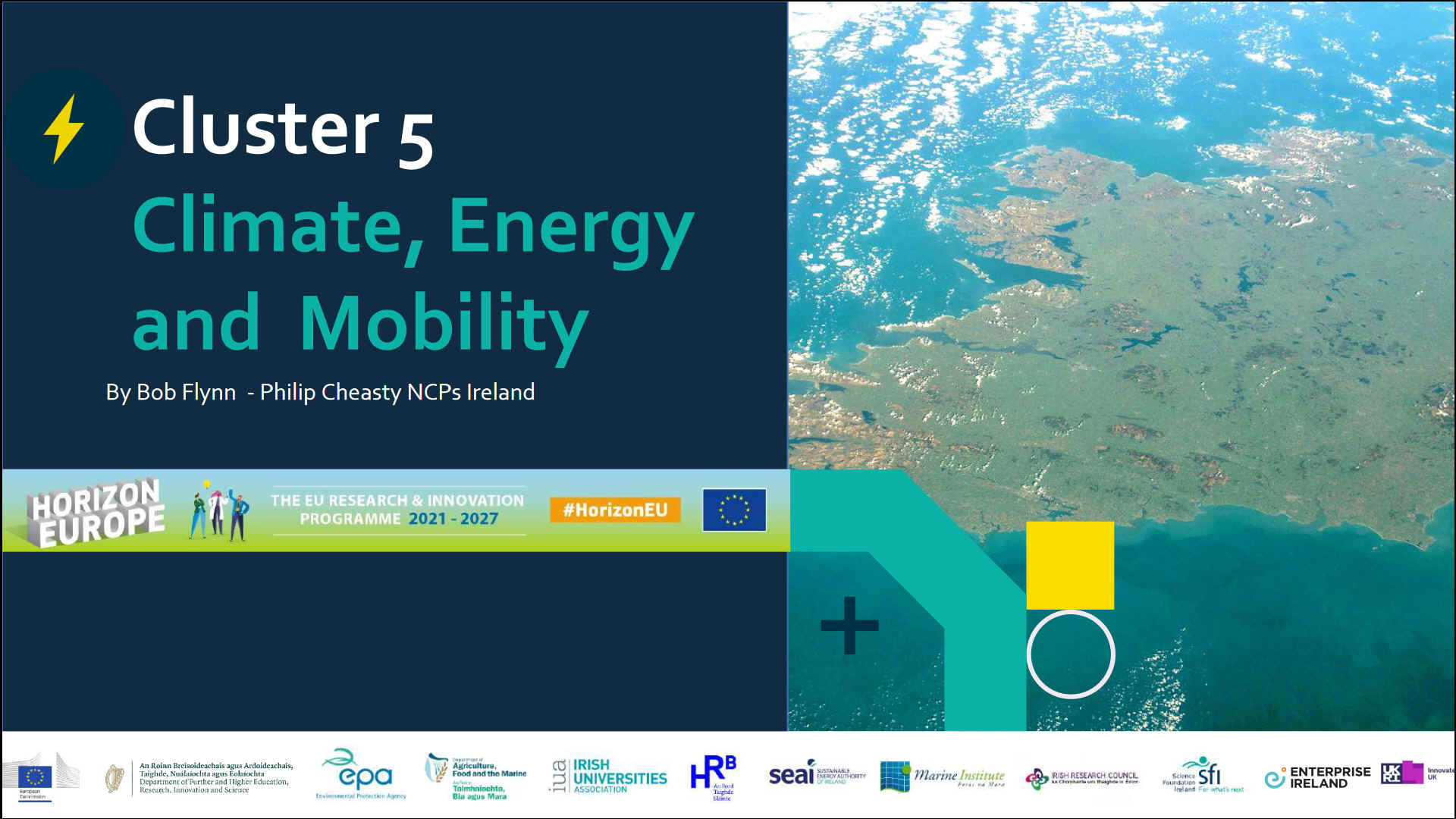
ENABLING
CLIMATE NEUTRAL, CLEAN, SMART, AND COMPETITIVE WATERBORNE TRANSPORT
The European Green Deal refers to the need to achieve clean, climate neutral shipping and waterborne operations and to the importance of research and innovation in this respect.
Waterborne transport, in particular where large sea-going vessels are used, remains an important emitter of GHG and the sector needs to step up its efforts on a significant scale and through a wide range of measures. Within the
International Maritime Organisation (IMO) global agreement was reached in 2018 to cut total shipping GHG emissions by at least 50% by 2050 compared to 2008 (baseline). The EU considers this too timid and is committed to a much higher level of ambition. By the same date the Union aims to cut all transport emissions by at least 90%.
Even though the share of Inland Waterway Transport with regard to global GHG emissions is of minor importance the Central Commission for the
Navigation of the Rhine (CCNR) and its Member States take various steps to reduce the GHG emissions of the fleet. In 2018 the Mannheim Declaration was adopted which incorporates the EU GHG reducing targets for inland navigation and these efforts are supported through this work programme.
To provide the innovations needed to achieve the targets and show global leadership (also in pushing far more ambitious global regulatory standards) a new co-programmed European Partnership “Zero Emission Waterborne Transport” (ZEWT) will mobilise resources and leverage private and public investments towards the central objective of demonstrating by 2030 the deployable solutions needed for all main types of waterborne transport to become “net zero emission” by 2050 at the latest. Most topics on waterborne transport will contribute to the implementation of this partnership. Projects under ZEWT partnership topics are expected to provide up to two presentations on progress made to the ZEWT partnership members, also with the aim to support the monitoring of the ZEWT partnership performance as well the necessary underlying development to make these achievements possible within the time frame of the partnership.
Furthermore, in the context of the EU’s digital strategy “A Europe Fit for the Digital Age” the waterborne transport sector will have to embrace a wide-ranging digitalisation, resulting in new business patterns, smart ports, automation of shipping and cargo handling (which will provide higher efficiency and significantly safer operations), autonomous vessels, and new design and decision tools.
Topics on waterborne transport under this Destination of the cluster 5 work programme address climate neutrality and protection of the marine environment, digitalisation, and industrial competitiveness with the aim to support all pertinent EU policy objectives, also with regard to synergies with related programmes like the Connecting Europe Facility and the EU Innovation Fund.
The main impacts to be generated by topics targeting waterborne transport under this Destination are:
Increased and early deployment of climate neutral fuels and significant electrification of shipping, in particular and foremost in intra-European transport connections.
Increased overall energy efficiency and drastically lower fuel consumption of vessels (important in light of more expensive alternative fuels for which the sector will have to compete with other transport modes).
Enable the innovative port infrastructure
(bunkering of alternative fuels and provision of electrical power) needed to achieve zero-emission waterborne transport (inland and maritime).
Enable clean, climate-neutral, and climate-resilient inland waterway vessels before 2030 helping a significant market take-up and a comprehensive green fleet renewal which will also help modal shift.
Strong technological and operational momentum towards achieving climate neutrality and the elimination of all harmful pollution to
air and
water.
Achieve the smart, efficient, secure and safe integration of maritime and inland shipping into logistic chains, facilitated by full digitalisation and
automation.
Enable fully automated shipping (maritime and inland) and efficient connectivity.
Competitive waterborne industries, including the globally active European maritime technology sector, providing the advanced green and digital technologies which will support jobs and growth in Europe.
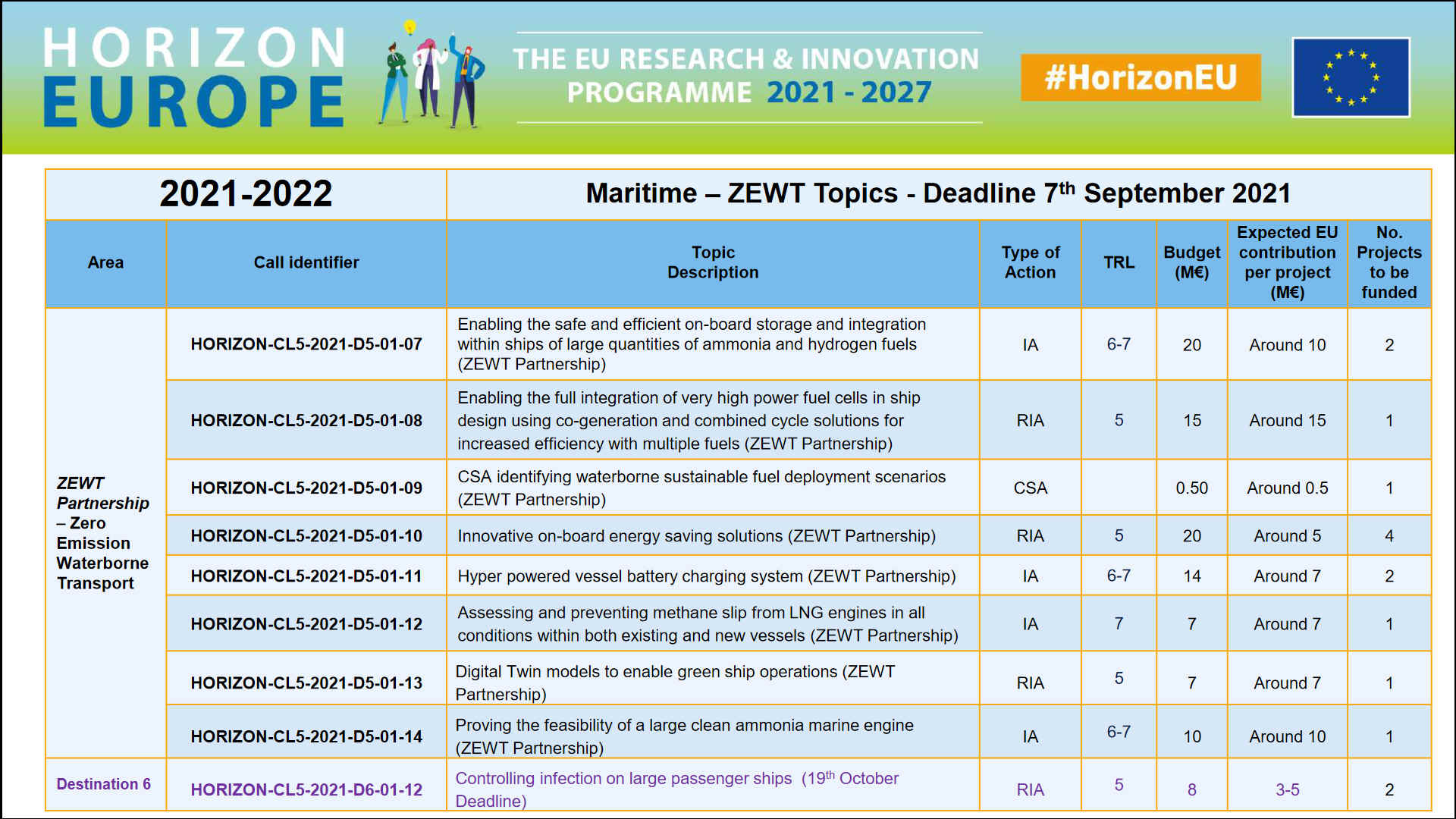
IMPACT
OF TRANSPORT ON ENVIRONMENT AND HUMAN HEALTH
Transport emissions are one of the main contributors to air quality problems, particularly in urban areas. At the same time, noise also negatively affects health. The World Health Organization (WHO) has classified traffic noise, including road, rail and air traffic, as the second most important cause of ill health in Western Europe, behind only air pollution caused by very fine particulate matter. Transport noise, particularly from road traffic, but also from rail and aviation, is a major contributor to noise pollution in urban areas. While type-approval noise limits for road vehicles, including their tyres, have been tightened over the years, the overall exposure to noise generated by road vehicles has not improved mainly due to increasing traffic volumes. L category vehicles are often perceived as a significant contributors to noise pollution and this might be due to the fact that noise emissions seem to be strictly optimised for specific conditions (but also due to tampering by their users, which in some cases is made too easy by the way the vehicles are built).
Electrification promises to address most of these issues, but as some transport modes are more difficult to electrify in the near future, there is need for research and innovation activities to develop appropriate and environmentally sustainable solutions. Furthermore, possible new pollutants and related health- challenges need to be monitored and investigated, and ways to deal with emissions by the existing fleet need to be studied and demonstrated.
The main impacts to be generated by topics targeting transport-related health and environmental issues under this Destination are:
- The better monitoring of the environmental performance and enforcement of regulation (detection of defeat devices, tampered anti-pollution systems, etc.) of fleets of transport vehicles, be it on road, airports and ports.
- Substantially reduce the overall environmental impact of transport (e.g.: as regards biodiversity, noise, pollution and waste)
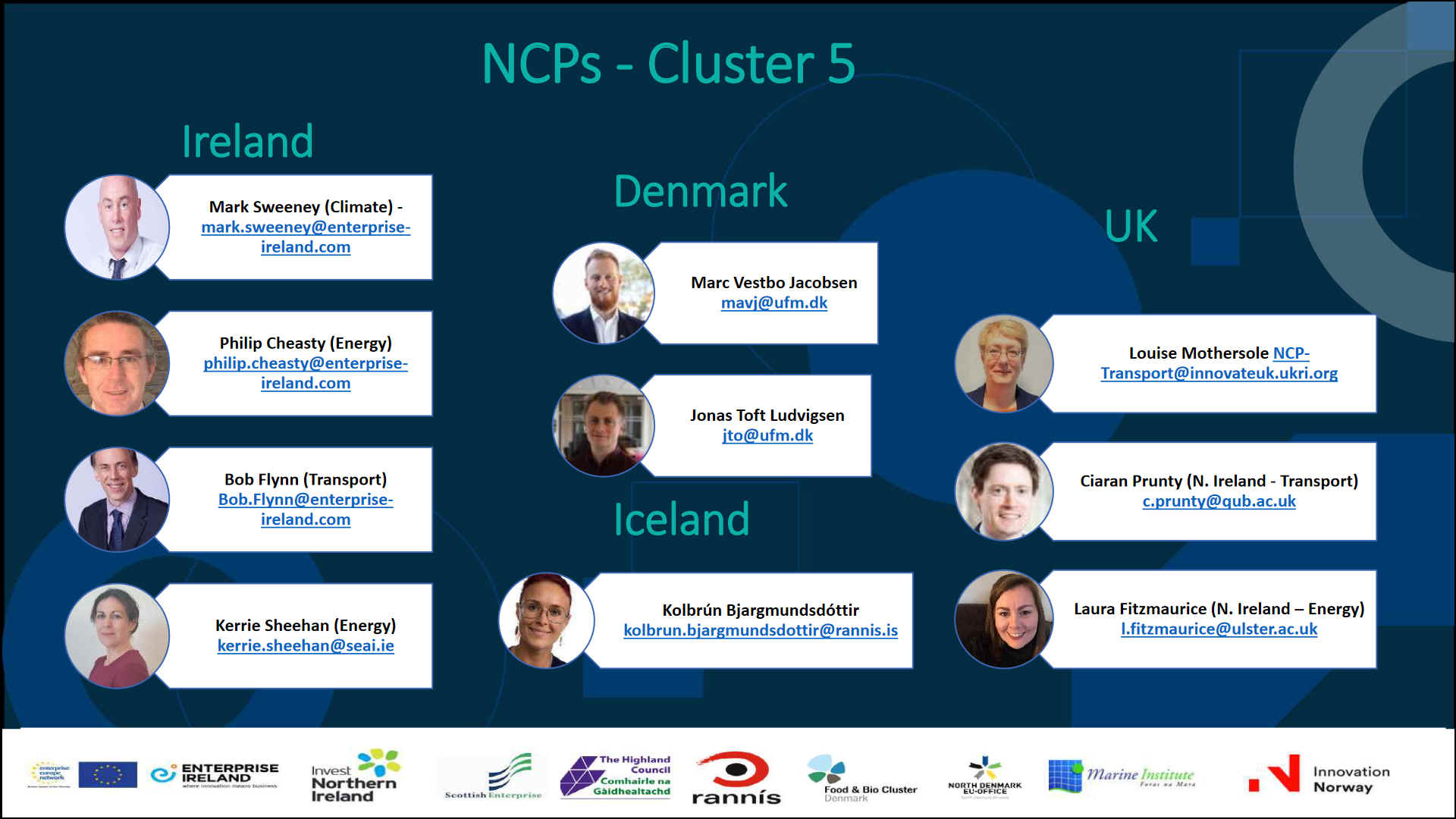
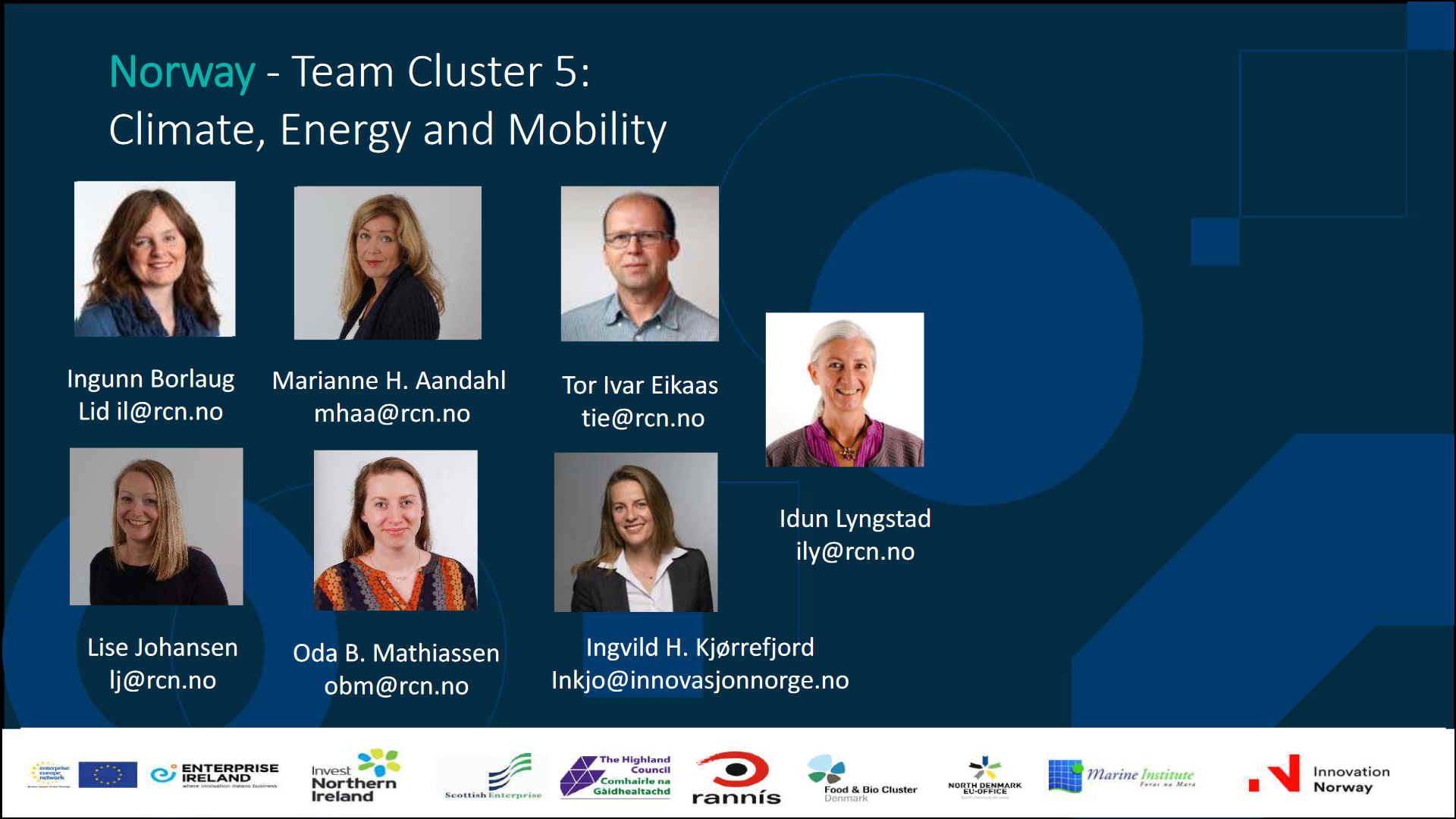
TOPIC CONDITIONS AND DOCUMENTS
General conditions
1. Admissibility conditions: described in Annex A and Annex E of the Horizon Europe Work Programme General Annexes
The page limit of the application is 70 pages.
Proposal page limits and layout: described in Part B of the Application Form available in the Submission System
2. Eligible countries: described in Annex B of the Work Programme General Annexes
A number of non-EU/non-Associated Countries that are not automatically eligible for funding have made specific provisions for making funding available for their participants in Horizon Europe projects. See the information in the Horizon Europe Programme Guide.
3. Other eligibility conditions: described in Annex B of the Work Programme General Annexes
4. Financial and operational capacity and exclusion: described in Annex C of the Work Programme General Annexes
5. Evaluation and award:
Award criteria, scoring and thresholds are described in Annex D of the Work Programme General Annexes
Submission and evaluation processes are described in Annex F of the Work Programme General Annexes and the Online Manual
Indicative timeline for evaluation and grant agreement: described in Annex F of the Work Programme General Annexes
6. Legal and financial set-up of the grants: described in Annex G of the Work Programme General Annexes
The funding rate is up to 60% of the eligible costs. This funding rate applies both to members and non-members of the partnership, except for non-profit legal entities, where the funding rate is up to 100% of the total eligible costs.
Specific conditions
7. Specific conditions: described in the specific topic of the Work Programme
DOCUMENTS
Call documents:
Standard application form — call-specific application form is available in the Submission System
The standard application form can be found in the link below, but be cautious that for this Call topic, the limit of 70 pages applies.
Standard application form (HE RIA, IA)
Standard evaluation form — will be used with the necessary adaptations
Standard evaluation form (HE RIA, IA)
MGA
HE General MGA v1.0
|
